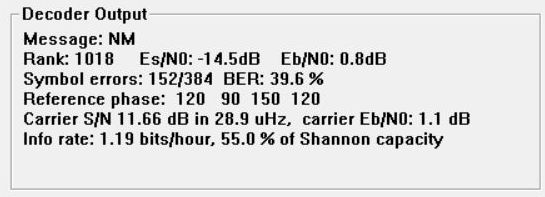I recently returned to doing some VLF monitoring. DK7FC has been improving his loading coils on his fixed TX antenna and testing on 2.7KHz. I tried receiving his test to no avail although he was received in Cumnia North Italy by IK1QFK 3 wavelengths distant, another Amateur Radio first ! The UK at 5 wavelengths seems to be impossible at the power levels available.
Attention was focussed back on 8.2KHz. I had never seen DK7FC on his fixed antenna. I improved my chances by using 1PPS GPS to Calibrate my soundcard. My first line resulted even copyable in 424uHz FFT.

DK7FC was also testing Data messages using EbNaut and RN3AUS managed to get a 2 symbol decode, yet another first, data at 0ver 900kM distance, this was also received by SQ5BPF and of course Paul Nicholson. By the time I got the necessary set up initialised the outrageous step of attempting a 7 symbol message was the next step.
Next morning my first file was ready to attempt a decode (I had practiced on the files from RN3AUS but this was at another level), I concentrated my attention on decoder, in just 7 Seconds, flash, the 7 symbol message :-
DREAMER
I was expecting a dry radio identity, what an apropriate word DK7FC had chosed for the first real text message on the band where we are “all dreamers who will never get a signal further than our own garden fence”.
RN3AUS also copied the message as well, as did Paul, there has been no news of a decode from SQ5BPF yet and apart from DF6NM who was transmitting at the same time, so not receiving, that is the full complement of those able to receive and decode EbNaut at the present time.
Oh yes ! In the excitement of the 7 symbol decode I had almost forgotten DF6NM was also transmitting EbNaut on 8.27KHz and I had my file. Was there any chance that I could decode his 2 symbol message, considering the greater distance, over 900kM and the fact that I have never detected his signal on my spectogram. Well we are out to attempt the impossible, we are Dreamers, so I went ahead. This time in 9 Seconds came the decode, an ident, NM.

What else can be achieved at VLF using what is after all QRP, what more firsts, DK7FC said of TX’ing on 2.7kHz “it is like walking on the moon”. No no, that has been done several times before.

